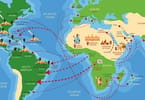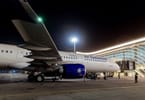This is a transcript of the remarks of Tony Tyler, head of the International Air Transport Association (IATA) at the Middle East and Africa Aviation Day, Abu Dhabi
”Competition and Cooperation for Stronger Middle East Aviation”
Your Highness, Excellencies, distinguished guests, ladies and gentlemen, good morning. It is truly a pleasure to be here in Abu Dhabi to welcome you to this Aviation Day. I’d like to thank James Hogan and Etihad Airways, the Abu Dhabi Government and our generous sponsors, for helping to make this event possible. As Hussein has mentioned, the success of aviation in this region has been remarkable. It is a source of great pride for me that if I am ever challenged over the benefits of air connectivity, I can immediately point to this region as proof of what can be achieved when aviation is harnessed in service of development.
Of course, such growth did not happen by accident. The industry needed visionary leaders to take risks. This region is fortunate to have benefitted from governments and rulers, CEOs and regulators, who could see the bigger picture. Most crucially, they were also prepared to invest. The Middle East has invested over $200 billion in more than 1,000 aircraft since 2005, and plans to spend a further $200 billion in the next 10 years. More than $100 billion has been spent on airport projects, most notably in Dubai, Doha, Oman, Jordan, and of course, here in Abu Dhabi. Saudi Arabia plans to invest $12.3 billion in its airports until 2020.
The result of this investment has not only transformed the economies of this region, it has helped to reshape our entire industry. Now the challenge is to look beyond merely national issues and focus on an even bigger picture – the strategic development of aviation across the entire Middle East.
70 years of the airline industry flying better together
Seeing the global big picture is one of IATA’s core attributes. We have been representing, leading and serving civil aviation for 70 years. In April 1945 a group of visionary airlines gathered in Havana, Cuba to found IATA. As World War Two went through its final stages it was clear that global aviation would play a big role in the post-war world.
Some 57 airlines from 31 countries drafted the articles of association for lATA which gave the organization three broad tasks:
To promote safe, regular and economical air transport for the benefit of the people of the world, to foster air commerce, and to study problems connected therewith
To provide means for collaboration among air transport enterprises engaged directly or indirectly with international air transport service and
To cooperate with the International Civil Aviation Organization (ICAO) and other international organizations
This mission has stood the test of time. Safety is still at the top of the priority list, and always will be. The safety performance in Africa and in the Middle East has been on an improving trend for some time. Last year, the jet hull loss rate for Middle East-North Africa (MENA) was 0.63 per million sectors flown – an improvement on the five-year trend of 1.82. In Africa, in 2014, there was not a single jet hull loss – an excellent achievement.
In safety, a key tool for improvement is compliance with global standards. The United Arab Emirates was recently commended by ICAO for the particularly impressive achievement of complying with 98.86% of all ICAO safety standards – the highest compliance rate in ICAO’s history.
Global standards, partnerships and collaboration are as critical for aviation today as they were seven decades ago – possibly even more so.
These priorities remain particularly appropriate for the Middle East. The enormous success that aviation has enjoyed in much of the region has created challenges that will require cooperation and visionary planning to overcome. In some ways the region is in danger of becoming a victim of its own success. The increase in aircraft movements has not been accompanied with an increase in the amount of available civil airspace. There are still some bottlenecks at key airports. And there are new pressures to create onerous taxation, increased airport and air traffic charges and regulatory obligations on the industry. In much of the region, consultation and transparency are not yet embedded in the aviation charges process. It is paramount that ICAO principles be followed.
The answer to these concerns is to embrace competition and collaboration. These twin strands have helped build the global aviation system we rely on today – and will continue to shape how our industry develops in decades to come.
Regional cooperation in air traffic management
I would like to start by focusing on perhaps the most pressing concern facing air transport in the region: air traffic management (ATM). This is an issue where cooperation is absolutely paramount. The Middle East – particularly the Gulf – is a strategic location with significant volumes of transiting air traffic. As both a destination region and a crossroads between Africa, Asia and Europe, airspace has to be planned efficiently. The rapid growth of air traffic originating, arriving and over-flying the Middle East Region—airlines in the region have reported more than 13% growth per annum over the last five years—requires more assertive measures to avert congestion.
The challenge is to increase the overall efficiency of the ATM system of the region through improved airspace design and organization. Moreover, individual developments in ATM and airspace capacity are not enough to deliver seamless operations, enhanced safety and sustainability. Harmonization, integration and collaboration among aviation stakeholders is essential to realize the full potential of national projects.
There is a great deal that can be achieved using current technology, processes and institutional arrangements. Single Sky concepts for the Gulf States are in the early stages of discussions, but this should not be the immediate priority.
ICAO has established the Middle East ATM Enhancement Program (MAEP), creating an umbrella under which all regional air navigation projects are prioritized and implemented. MAEP will focus on regional efforts to overcome fragmented airspace structures.
It is also important that the MAEP is coupled with the development of a suitable and sustainable airspace infrastructure to meet the projected increase in demand. The need for action is urgent, and strong political will is required. All MENA countries should be fully committed. We can start with ATM modernization, through the renovation of systems, processes and equipment. Available airspace for civil aviation can be expanded by implementing operational concepts such as Flexible Use of Airspace. And tools such as Air Traffic Flow Management and Collaborative Decision Making should be considered a priority.
Regulatory balance for effective consumer protection
From an example of cooperation, I now want to look at a topic where competition is crucial: the issue of consumer protection. You may be asking yourself what competition has to do with consumer rights, but in the case of aviation, it is integral. Air transport is an almost uniquely competitive market, at least for airlines. No airline wants to lose customers, so they work hard to make sure the vast majority of passengers get to their destinations on time.
Passenger rights regulation should not interfere with these market forces, which will allow passengers to make their own choices based on their experiences. Consumer protection laws are an upcoming issue in the region. We recognize that consumers need to be looked after – but aviation has been doing that very well for decades. Regulations should follow principles that ensure fair and responsible treatment. Moreover, a focus by Middle Eastern governments on the provision of information, as opposed to regulation, would ensure people have the ability to make well-informed travel choices and preserve the growth the region has become known for.
The Arab Civil Aviation Commission (ACAC) has issued draft guidelines on consumer protection for consideration by governments. Unfortunately, the guidelines are prescriptive in nature and do not serve either airlines or consumers well. For example, the imposition of set compensation for delays deviates from the Montreal Convention – ignoring international practice and the fact that airlines are highly incentivized to avoid delays in the first place. Most worryingly, the draft also does not emphasize the preeminence of safety by failing to exclude safety-related delays, diversions and cancellations from the list of events for which compensation can be claimed. Safety must always come first. And we should never place pilots in the position where their operational decisions made in the interests of safety could result in government-imposed financial penalties. Thankfully, the ACAC Executive Committee has asked for further revisions to the document before approving it.
Those revisions should take into account the ICAO and airline industry’s work on the subject of consumer protection. In June 2013, IATA member airlines unanimously adopted a set of core principles on consumer protection. These are based on lessons-learned from existing regimes, and attempt to strike a balance between protecting passengers and maintaining industry competitiveness. Key elements include never compromising with safety, ensuring passengers have access to fare and operating carrier information, complaint handling systems, and the need to align with existing international conventions. We’re working hard to explain the value of these principles to governments across the region. For example, I understand a workshop in Qatar is scheduled for next month.
Global standards for a competitive industry
Not only do we want to ensure passengers are appropriately looked after on the rare occasions when expectations do not meet reality – we are also working on giving them even greater choice before their flight even starts.
One of our most significant initiatives is the New Distribution Capability (NDC). As airlines develop bundled and unbundled fares, passengers need to be able to shop and compare the value of these options across airlines—just as they do when shopping for other consumer goods. NDC gives them this ability through the development of a modern, internet-based data standard for communications between airlines and travel agents. As a result, air travelers will benefit from greater transparency and access to all of an airline’s offerings when shopping via a travel agent or online travel site, which is not the situation today. And airlines will be able to move beyond the mostly commoditized displays of fares and schedules in the travel agent channel, to present their products in a more attractive and competitive manner. We are making strong progress on NDC. Some 24 airlines are undertaking pilots or implementations, including Qatar Airways. And I am delighted to announce that yesterday, Rotana Jet became the first airline in the region to deliver live NDC transactions.
The giants of Middle East aviation will be coming on board with NDC in the very near future, but I am pleased that Rotana has been able to implement it already. It proves that there is no barrier to any airline taking advantage of this new initiative. Rotana is not an IATA member, nor is it a particularly large airline. But His Highness Dr. Ahmed bin Saif Al-Nehyan’s leadership has recognized the value of NDC and his team has worked hard, with IATA’s help, to integrate it into the airline’s systems.
NDC is the perfect illustration of how collaboration on global standards helps to spark even greater innovation and competition within the airline sector. And with their burgeoning reputation for service quality, I am sure Middle Eastern carriers will be well-placed to prosper with this new platform.
United in our commitment to a sustainable industry
Before I conclude, I would like to touch on the issue of the environment and industry unity. Air transport has transformed the world. But the economic development we have enabled has created an acute environmental challenge. Our industry has a responsibility to be part of the solution to that challenge. To our credit, we were one of the first global industries to put in place strong targets and a robust strategy to mitigate carbon emissions.
The aviation industry is committed to delivering carbon-neutral growth from 2020, and cutting emissions 50% by 2050 compared to 2005. Achieving this will not be easy, but we have a credible 4-pillar strategy to do so. The first three pillars – new technology, improved operations, and better use of infrastructure – have already brought results. The fourth pillar is something that only governments can deliver, through ICAO: a global market-based measure or MBM, to drive carbon reductions.
In September next year, the ICAO Assembly will make its decision on an MBM. In the hands of 190 states will be the power to make aviation’s carbon-neutral growth goal a reality. It is no exaggeration to say that the eyes of the world will be on them.
The stakes are high. If an agreement on an MBM is reached, then aviation will have taken its claim to be at the forefront of the practical fight against man-made climate change one giant step further. It’s the right thing to do and will grant us a license to continue the important work of connecting our planet.
I hope and believe that a workable MBM will be put in place. But it will not be easy. There is hard work ahead, and it will need the industry to stand united as the details are worked out. Failure to remain unified could lead to an untenable patchwork of regulation, taxes, charges and onerous measures yet to be conceived.
Flying better, together
I said at the beginning of this address that the next challenge for this region is to plan strategically for the future. We all know how hard it is to plan for an uncertain world. But 70 years of experience tells us that whatever the challenges, aviation overcomes them best by cooperating together on the fundamental standards of a safe, secure and sustainable air transport system. Then we take those standards and in a spirit of competition, innovate for an even stronger industry.
The next two decades are poised to be exciting ones for aviation in the Middle East. Our 20-year forecast estimates passenger growth in the region will be among the fastest in the world. The Middle East is set to expand by 4.6% per year to become a market of 365 million passengers, while Africa will grow 4.4% per year, reaching 280 million. Airlines in the region are expected to become even stronger as they leverage the unique position of the region to service fast-growing markets in Africa and Asia. But the region’s aviation system needs to be ready. I hope that this Aviation Day helps prepare the ground for the essential work that we – airlines, airports, regulators and governments – need to do to foster innovation and competition to drive connectivity and respond to the global demand for flight. Events like today help to cement partnerships within the region, to work for mutual benefit. I would like to mention especially the close relationship between IATA and the Arab Air Carriers Organization (AACO). AACO is itself celebrating a significant milestone this year—50 years of working to strengthen aviation in this region. Many congratulations on this achievement and we look forward to continuing our partnership in the years to come.
The celebration of 70 years of industry cooperation through lATA reminds us of the enormous value that airlines have created by working together: global mobility for 3.5 billion travelers and 50 million tonnes of cargo. It’s a powerful license to build our future as an industry that is ever safer, more efficient and sustainable.
Let’s create stronger Middle East aviation by flying better. Together!
WHAT TO TAKE AWAY FROM THIS ARTICLE:
- It is a source of great pride for me that if I am ever challenged over the benefits of air connectivity, I can immediately point to this region as proof of what can be achieved when aviation is harnessed in service of development.
- To promote safe, regular and economical air transport for the benefit of the people of the world, to foster air commerce, and to study problems connected therewith.
- Now the challenge is to look beyond merely national issues and focus on an even bigger picture – the strategic development of aviation across the entire Middle East.






















